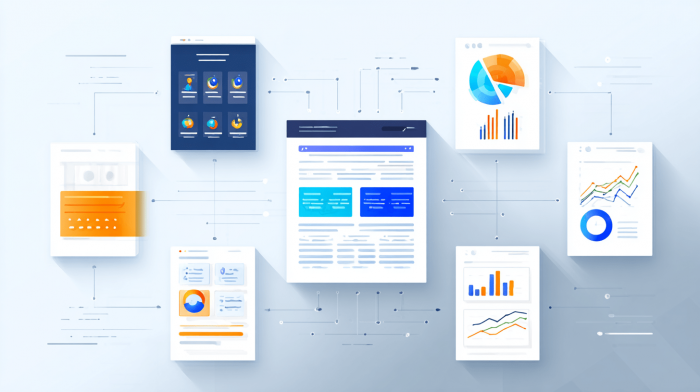The mere existence of a corporate website doesn’t guarantee full communication with the audience. Typically, such a resource only delivers key information and outlines the structure of services, forming a general impression of the company. But when that’s no longer enough and visitors require deeper engagement, the need for another format arises. This is when a blog comes to the forefront – answering common questions even before contact, explaining the logic behind decisions, and gently guiding the potential client toward action. Still, some owners don’t view it as a necessary component, postponing its creation indefinitely or not thinking about it at all. So let’s take a closer look at why it’s important to have a blog on your company’s corporate website, how to prepare for its launch, and what to consider after going live.

What advantages a corporate blog gives to the owner
For anyone planning a creation of turnkey website, we immediately recommend integrating a blog into its structure, since its implementation:
- Provides a stable source of organic traffic. When the website features publications that address real queries from potential clients, it consistently attracts new audiences without ad spend or seasonal dependency.
- Serves as a trust channel for the company. Carefully written texts that clearly explain product specifics, working conditions, and the company’s approach create a sense of openness and build trust even before personal interaction.
- Explains product value without pressure. Instead of directly convincing someone of “high quality” or “uniqueness,” the blog allows you to show the essence and logic behind the offering, helping clients reach their own conclusions – without feeling pressured.
- Creates an information base for the team. The texts on the website containing answers, case studies, and clarifications serve both external audiences and help managers quickly navigate arguments and common situations.
- Ensures visibility in related search topics. Even if someone isn’t looking for your company directly but is reading about something related, they might land on your blog and learn about you in a completely organic context – without ads or promotion.
- Reduces repetitive explanation costs. Everything that constantly needs to be explained to each client – processes, pricing, nuances – is written out once and then simply shared as a ready answer, saving the team’s time.
- Gradually boosts brand recognition within the niche. The more often your texts appear in search results, discussions, or recommendations, the stronger the association with the subject matter becomes – even if the client isn’t ready to reach out yet.
Who needs a blog and in what cases
When deciding who should use the service of developing a corporate website with a blog, we focus on niches where the client doesn’t make decisions immediately but only after reflection and analysis. If the product is complex, the service requires explanation, and price isn’t the only argument – it’s important to give the person room to think without added pressure. A blog is perfect for this, building trust gently before any direct interaction. It’s especially relevant for B2B, studios, agencies, expert teams, manufacturing firms, and anyone whose work needs clear explanation before the client can assess its value.
A blog makes even more sense for businesses that are actively growing – launching new directions, expanding their portfolio, serving multiple audiences, or just establishing themselves in the market. When there’s no clear public image yet, explaining your approach, showing practice, and being present in the topic helps with recognition and strengthens your position. In such cases, a blog becomes a full part of brand communication, as detailed in our article on website development for fitness centers, where we explore the benefits of integrating a blog into the site structure.

What’s needed to implement a blog on the company website
When launching a blog, we take a comprehensive approach and follow this clear step-by-step process:
| Site audit. | After the initial consultation, we analyze the current state of the website – from technical aspects to page structure – to determine how best to integrate the blog without harming the existing layout or SEO visibility. |
| Defining the target audience. | We clearly define who the content is for, considering user awareness, their motivation to visit the site, and behavioral patterns that influence the end result. |
| Creating categories and content blocks. | Based on reader expectations and the offer’s specifics, we organize content into clear thematic sections that allow for a consistent long-term content strategy. |
| Agreeing on blog design. | We coordinate the design to match the site’s overall style, ensuring comfortable reading and maintaining logical content presentation throughout the section. |
| Setting up administration. | We organize internal content management so the team can later update posts independently without spending extra on technical adjustments. |
| Preparing a content plan. | We create a detailed publishing calendar considering seasonality, business priorities, and audience interests, focusing on both filling the blog and supporting the company’s strategic development. |
| Agreeing on KPIs and reporting. | We define which metrics will measure the blog’s effectiveness – such as reach, subscriptions, engagement depth, or traffic growth – and implement regular tracking of progress. |
How to support and develop the blog after launch
Maintaining a blog means not only regularly publishing new material but also working with existing content. Over time, some articles become outdated due to shifts in company focus or audience expectations, while others may need adjustments to reflect new communication priorities. If this isn’t done, the blog quickly loses credibility – and what was meant to clarify starts to confuse, giving an impression of neglect instead of strengthening your reputation. This is especially true when old texts still get traffic but no longer align with the company’s real offerings.
Content updates should also involve rethinking the blog’s role in your broader marketing system. Posts shouldn’t exist in isolation – they need to support sales, complement ad campaigns, and address key questions even before clients reach out. That requires alignment with other channels, responsiveness to feedback, and a clear understanding of what each publication is meant to do. If these connections are properly built, the blog naturally evolves with the business, remaining a relevant tool for engaging your audience.
Mistakes to avoid when running a blog
Even if a blog was included in the structure during the initial development of an informational website, that doesn’t guarantee it will actually benefit the company. A high-quality tool becomes useless if it’s used poorly, especially when common mistakes are made, such as:
- Lack of comment moderation. If questions, spam, or provocative posts appear under articles and the company ignores them, the impression of openness and readiness for dialogue quickly fades – along with user trust.
- Ignoring reader-friendly formatting. A lack of visual emphasis – headings, paragraphs, lists, highlights – makes the text harder to read and reduces engagement, especially with information-dense topics.
- Overloading texts with technical detail. Excessive specifics without explanation, analogy, or example makes even valuable data hard to digest, especially if the target audience isn’t highly technical.
- Blog not integrated with social media. If content is posted in isolation – without adaptation, references, or even mention on other channels – the crowd-communication effect is lost, and the blog stops supporting overall brand presence.
- Full copying of external materials. Using non-original content without adapting it to your approach or internal context harms SEO and reduces the blog’s value as a unique information source.

Planning to expand your corporate website and thinking about starting a blog? Or maybe you already have one and want to increase its effectiveness in your business processes? Then we invite you to collaborate. Our specialists will analyze your resource, suggest the optimal blog implementation format, and provide it with quality content. They’ll also explain why it’s important to regularly update your website and advise you on what to prepare for at the start to avoid future issues. Contact us – the QuatroIT team is at your service.











